Grid computing is the use of widely distributed computer resources to reach a common goal. A computing grid can be thought of as a distributed system with non-interactive workloads that involve many files. Grid computing is distinguished from conventional high-performance computing systems such as cluster computing in that grid computers have each node set to perform a different task/application. Grid computers also tend to be more heterogeneous and geographically dispersed than cluster computers. Although a single grid can be dedicated to a particular application, commonly a grid is used for a variety of purposes. Grids are often constructed with general-purpose grid middleware software libraries. Grid sizes can be quite large.

In computer science, evolutionary computation is a family of algorithms for global optimization inspired by biological evolution, and the subfield of artificial intelligence and soft computing studying these algorithms. In technical terms, they are a family of population-based trial and error problem solvers with a metaheuristic or stochastic optimization character.
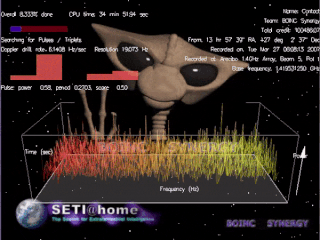
SETI@home is a project of the Berkeley SETI Research Center to analyze radio signals with the aim of searching for signs of extraterrestrial intelligence. Until March 2020, it was run as an Internet-based public volunteer computing project that employed the BOINC software platform. It is hosted by the Space Sciences Laboratory at the University of California, Berkeley, and is one of many activities undertaken as part of the worldwide SETI effort.

The Berkeley Open Infrastructure for Network Computing is an open-source middleware system for volunteer computing. Developed originally to support SETI@home, it became the platform for many other applications in areas as diverse as medicine, molecular biology, mathematics, linguistics, climatology, environmental science, and astrophysics, among others. The purpose of BOINC is to enable researchers to utilize processing resources of personal computers and other devices around the world.

LHC@home is a volunteer computing project researching particle physics that uses the Berkeley Open Infrastructure for Network Computing (BOINC) platform. The project's computing power is utilized by physicists at CERN in support of the Large Hadron Collider and other experimental particle accelerators.

Within the BOINC platform for volunteer computing, the BOINC Credit System helps volunteers keep track of how much CPU time they have donated to various projects. This ensures users are returning accurate results for both scientific and statistical reasons.
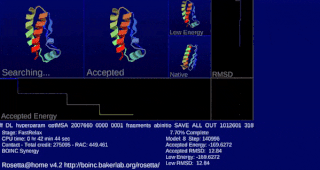
Rosetta@home is a volunteer computing project researching protein structure prediction on the Berkeley Open Infrastructure for Network Computing (BOINC) platform, run by the Baker laboratory at the University of Washington. Rosetta@home aims to predict protein–protein docking and design new proteins with the help of about fifty-five thousand active volunteered computers processing at over 487,946 GigaFLOPS on average as of September 19, 2020. Foldit, a Rosetta@home videogame, aims to reach these goals with a crowdsourcing approach. Though much of the project is oriented toward basic research to improve the accuracy and robustness of proteomics methods, Rosetta@home also does applied research on malaria, Alzheimer's disease, and other pathologies.
Human-based computation (HBC), human-assisted computation, ubiquitous human computing or distributed thinking is a computer science technique in which a machine performs its function by outsourcing certain steps to humans, usually as microwork. This approach uses differences in abilities and alternative costs between humans and computer agents to achieve symbiotic human–computer interaction. For computationally difficult tasks such as image recognition, human-based computation plays a central role in training Deep Learning-based Artificial Intelligence systems. In this case, human-based computation has been referred to as human-aided artificial intelligence.

BOINC client–server technology refers to the model under which BOINC works. The BOINC framework consists of two layers which operate under the client–server architecture. Once the BOINC software is installed in a machine, the server starts sending tasks to the client. The operations are performed client-side and the results are uploaded to the server-side.

Volunteer computing is a type of distributed computing in which people donate their computers' unused resources to a research-oriented project, and sometimes in exchange for credit points. The fundamental idea behind it is that a modern desktop computer is sufficiently powerful to perform billions of operations a second, but for most users only between 10–15% of its capacity is used. Common tasks such as word processing or web browsing leave the computer mostly idle.
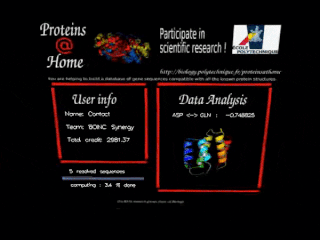
proteins@home was a volunteer computing project that used the BOINC architecture. The project was run by the Department of Biology at École Polytechnique. The project began on December 28, 2006 and ended in June 2008.

Cosmology@Home is a volunteer computing project that uses the BOINC platform and was once run at the Departments of Astronomy and Physics at the University of Illinois at Urbana-Champaign. The project has moved to the Institut Lagrange de Paris and the Institut d'Astrophysique de Paris, both of which are located in the Pierre and Marie Curie University.
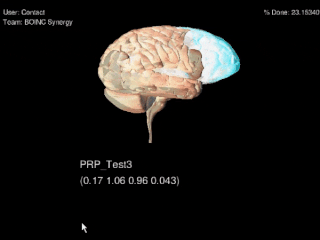
MindModeling@Home is an inactive non-profit, volunteer computing research project for the advancement of cognitive science. MindModeling@Home is hosted by Wright State University and the University of Dayton in Dayton, Ohio.

MilkyWay@home is a volunteer computing project in the astrophysics category, running on the Berkeley Open Infrastructure for Network Computing (BOINC) platform. Using spare computing power from over 38,000 computers run by over 27,000 active volunteers as of November 2011, the MilkyWay@home project aims to generate accurate three-dimensional dynamic models of stellar streams in the immediate vicinity of the Milky Way. With SETI@home and Einstein@home, it is the third computing project of this type that has the investigation of phenomena in interstellar space as its primary purpose. Its secondary objective is to develop and optimize algorithms for volunteer computing.

AQUA@home was a volunteer computing project operated by D-Wave Systems that ran on the Berkeley Open Infrastructure for Network Computing (BOINC) software platform. It ceased functioning in August 2011. Its goal was to predict the performance of superconducting adiabatic quantum computers on a variety of problems arising in fields ranging from materials science to machine learning. It designed and analyzed quantum computing algorithms, using Quantum Monte Carlo techniques.

Docking@Home was a volunteer computing project hosted by the University of Delaware and running on the Berkeley Open Infrastructure for Network Computing (BOINC) software platform. It models protein-ligand docking using the CHARMM program. Volunteer computing allows an extensive search of protein-ligand docking conformations and selection of near-native ligand conformations are achieved by using ligand based hierarchical clustering. The ultimate aim was the development of new pharmaceutical drugs.

Help Cure Muscular Dystrophy is a volunteer computing project that runs on the BOINC platform.
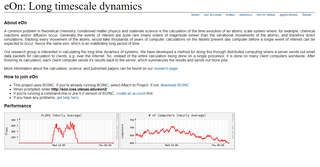
eOn was a volunteer computing project running on the Berkeley Open Infrastructure for Network Computing (BOINC) platform, which uses theoretical chemistry techniques to solve problems in condensed matter physics and materials science. It was a project of the Institute for Computational Engineering and Sciences at the University of Texas.

theSkyNet was a research project that used volunteer Internet-connected computers to carry out research in astronomy. It was an initiative of the International Centre for Radio Astronomy Research (ICRAR), a joint venture of Curtin University and the University of Western Australia. theSkyNet had two projects, Sourcefinder and POGS. Both projects have been completed. theSkyNet Sourcefinder aimed to test and refine automatic radio sourcefinding algorithms in preparation for radio galaxy surveys using the Australian Square Kilometre Array Pathfinder and the Square Kilometre Array. theSkyNet POGS used Spectral Energy Distribution fitting to calculate characteristics of many galaxies using images taken by the Pan-STARRS PS1 optical telescope in Hawaii.
Social cloud computing, also peer-to-peer social cloud computing, is an area of computer science that generalizes cloud computing to include the sharing, bartering and renting of computing resources across peers whose owners and operators are verified through a social network or reputation system. It expands cloud computing past the confines of formal commercial data centers operated by cloud providers to include anyone interested in participating within the cloud services sharing economy. This in turn leads to more options, greater economies of scale, while bearing additional advantages for hosting data and computing services closer to the edge where they may be needed most.

















